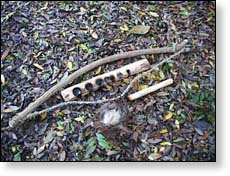
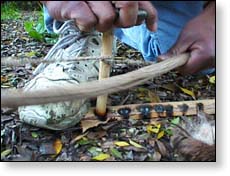


The components of the bow drill consist of the spindle, the
hearthboard, bow and the bearing block.
Downward pressure is applied by pushing down on the bearing block
and rotation on the spindle is generated by the bow.
In the right hand photo above, notice that the string closest
to the left hand holding the bow is underneath the other half
of the string. The left thumb is used to push down on the string
to separate the string as the spindle is rotating. This keeps
the string from abrading each other. Also in the right hand photo
above, the right wrist is locked into the shin of the right leg
to stabilize the rotating spindle.
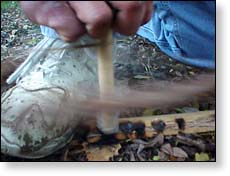

Place a leaf underneath the notch to catch the char dust.
Use a consistent sawing motion to create some char build-up in
the notch. Continue to rotate the spindle as the hearthboard begins
to smoke and the char dust ignites into a ember.
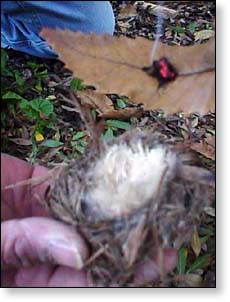
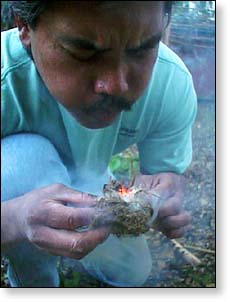
Transfer the glowing ember from the leaf to the the tinder bundle. The white, cattail down in the tinder bundle of the above, left photo will help to extend the fire of the ember. Blow into the tinder bundle to increase the fire of the ember.
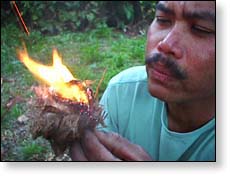
Continue blowing until the tinder bundle bursts into flames.
The spindle was California Buckeye. The hearthboard was Incense
Cedar. The wooden bow was willow and the string was made from
Flax. The bearing block was from a piece of soapstone.
The tinder bundle was from the bast fibers of cottonwood with
some cattail down in the middle.
E-mail your comments to "Dino Labiste" at KahikoArts@yahoo.com
E-mail questions answered
about fire-by-friction.
We hope the information on the PrimitiveWays website is both instructional and enjoyable. Understand that no warranty or guarantee is included. We expect adults to act responsibly and children to be supervised by a responsible adult. If you use the information on this site to create your own projects or if you try techniques described on PrimitiveWays, behave in accordance with applicable laws, and think about the sustainability of natural resources. Using tools or techniques described on PrimitiveWays can be dangerous with exposure to heavy, sharp or pointed objects, fire, stone tools and hazards present in outdoor settings. Without proper care and caution, or if done incorrectly, there is a risk of property damage, personal injury or even death. So, be advised: Anyone using any information provided on the PrimitiveWays website assumes responsibility for using proper care and caution to protect property, the life, health and safety of himself or herself and all others. He or she expressly assumes all risk of harm or damage to all persons or property proximately caused by the use of this information.
© PrimitiveWays 2013